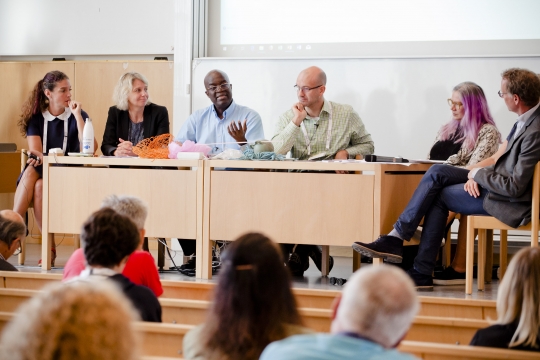WCERE 2018: One policy session during the conference adressed economic incentives and policy instruments to handle marine plastic pollution. One conclusion that came out was that there is a need for clear incentives that drives producers to take responsibility for the whole life cycle of their products.
Marine plastic pollution is one of the key topics discussed in relation to UN Sustainable Development Goal (SDG) 14 and the objective of Healthy oceans. It is evidently not just one problem with one answer, but a complex mix of different threats to the environment and human health, caused by different type of plastic material and products and handled by a range of actors in different part of the value chain. Plastic pollution also brings the more invisible issue of risk management of chemicals into the discussion.
There is an increasing amount of research published clarifying the flow of plastics, its effect on the environment and people’s health, as well as on solutions to handle its negative effects. Marine plastic pollution is however not a hot topic amongst researchers in economics, and very few publications from environmental economists have been published. During the World Congress of Environmental and Resource Economics (WCERE), in Gothenburg the last week in June, the Environment for Development, Centre for Sea and Society, with support from the Region Västra Götaland, arranged a policy session initiating a discussion about economic incentives and policy instruments to handle marine plastic pollution.
One conclusion from this session was that it would be very useful to have a general understanding of how different types of policy instruments are used in relation to the different levels and parts of the plastic pollution problem. It was also concluded that there is a need for clear incentives driving producers to take responsibility for the whole life cycle of their products. In contrast to a linear economy based on ”taking, making and disposing”, there is a need for a circular economy, where responsibility for the products whole life cycle is taken. This shift in economic systems and material cycles would demand much more knowledge about the use of a product and its ability to be reused or recycled already during the stage of planning of the production.
Bethanie Carney Almroth, associate professor at the University of Gothenburg and linked to the FRAM center, started her presentation by stating that plastic are fantastic materials that contribute to the achievement of several of the sustainability goals, like goal 2 Zero hunger, by the protection of food in plastic packages and increased hygiene, goal 3 Good health and well-being throuch the use of plastic medical materials etc. and goal 6 Clean water and sanitation, giving us pipes and materials to purify, store and transport water.
She also described how plastics now also has become threat to the same goals by the Pollution of water, oceans and land (goal 14 and 15) as well as Unsustainable consumption (goal 12). E.g. whales, seals, turtles, and birds become entangles in macro-plastics, lost fishing gears, and plastic bags. More than 800 species have been found with plastics in their bodies, as the plastics is mistaken for food (CBD Report Technical Series no 83).
Of the 8300 million tons of plastic ever been produced, only 9% has been recycled and 12% has been incinerated. The rest is still around and not only in the oceans but in our entire technosphere (Geyer et al, 2017). The dramatic increase in production of plastics is mainly relating to packaging material, often used only once before disposal. The sources of plastic pollution comes from all stages of its life cycle, but there is not sufficient scientific results to clearly understand the effects of plastics and the so-called microplastics (often defined as particles <5 mm). Microplastics can form during fragmentation of macro plastics but can also leak into the environment from products where these are used intentionally (eg. cosmetics) or from the production of the raw plastic material (Karlsson et al 2018). Noteworthy is also that plastic is not one pure material, but a number of different polymers, and numerous different chemicals that are formed during processing or added to the materials to give them their specific characteristics (such as phthalates, pigments etc.).
Many studies are based on laboratory experiments and it is not yet possible to state the magnitude of the risks associated with exposure to plastic, micro-plastics and the complex chemical cocktails that contains within these materials in the marine environment. Although the focus has been on the plastic pollution in the ocean, many new studies shows the plastic pollution as a general problem, as plastic is found all over the globe. In order to address the problem sufficiently there is a need to understand the role of different actors.
When designing policy instruments it’s important to understand the relation between the type of plastics and actors (Bethanie Carney-Almroth).
Henrikke Baumann, Professor in Industrial and Domestic Ecologies, at Chalmers University of Technology, drew a systems perspective on the plastic material from production to consumption and disposal or recycling. She described the main sources of leakages of plastic material within this system but emphasized that marine plastic pollution should be characterized as an environmental problem rather than a resource problem.
A panel discussion including also Anna Jöborn, Director at the Swedish Agency for Marine and Water Management, Rashid Sumaila, Resource Economist, Professor and Director of the Fisheries Economics Research Unit, University of British Columbia and Joshua Abbott, Resource Economist, Associate Professor, School of Sustainability, Arizona State University, took it starting point from a number of plastic items at the table, including fishing gear, cigarette butts, plastic bags, straws and other single-use products. The economists were unanimous that there might be good also economic, arguments, to ban certain products, like plastic bags. But it is also essential to understand the consequences of a ban and by what the banned product will be replaced. In relation to fishing gears a number of policy instruments were suggested, like labeling, taxation and deposit-systems, necessary to be specifically designed for the relevant type of fishing and society. Waste management could definitely be improved in order to get plastic material recycled but was not suggested to be the key solution.
The discussion showed the complexity in the problem of marine plastic pollution, and the need of policy response building on facts, recognition of the whole value chain and to design policy instruments in relation to the specific environment and societies they address. So, lots of exiting challenges for researchers to grasp, not least in environmental economics and other social sciences.
Photo on top; the panel at the World Congress of Environmental and Resource Economics: Anna Jöborn (Swedish Agency for Marine and Water Management), Bethanie Carney Almroth, (University of Gothenburg), Rashid Sumaila (University of British Columbia), Joshua Abbott (Arizona State University), Henrikke Baumann(Chalmers University of Technology) and moderators from University of Gothenburg Lena Gipperth and Håkan Eggert.
References:
- Marine debris: understanding, preventing and mitigating the significant adverse impacts on marine and coastal biodiversity. 2016. Technical Series No.83. Secretariat of the Convention on Biological Diversity, Montreal, 78 pages.
- Geyer et al., 2017. Production, use, and fate of all plastics ever made. Science Advances. Vol. 3, no. 7. https://doi.org/10.1126/sciadv.1700782
- Karlsson, T. et al. 2018. The unaccountability case of plastic pellet pollution. Marine Pollution Bulletin. Volume 129, Issue 1, Pages 52-60. https://doi.org/10.1016/j.marpolbul.2018.01.041
BY: LENA GIPPERTH

